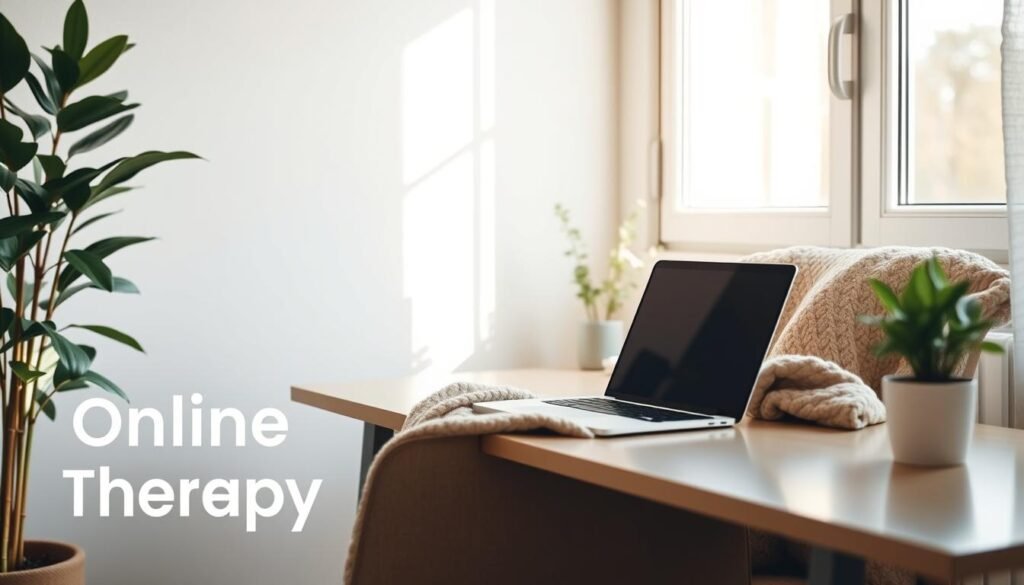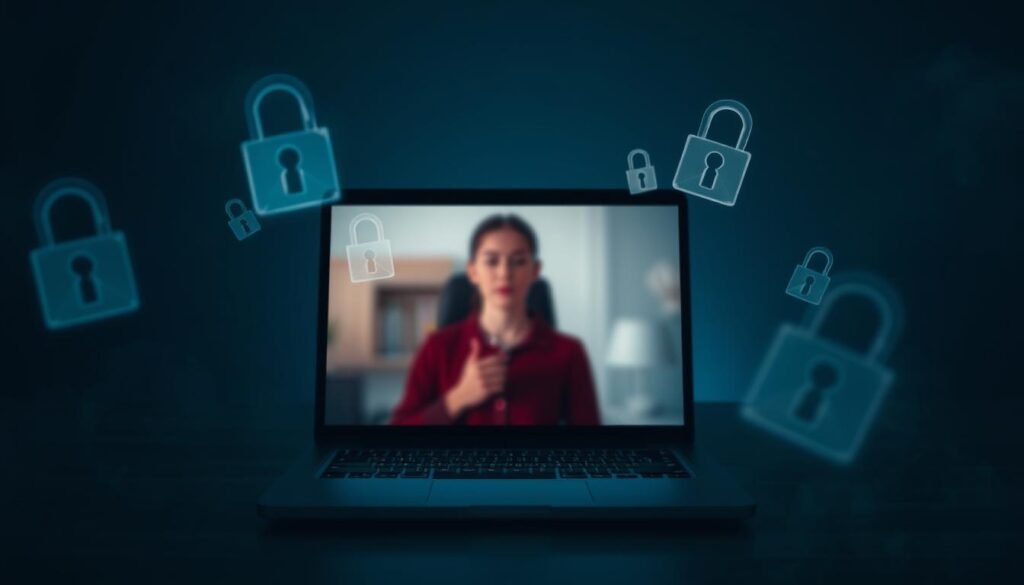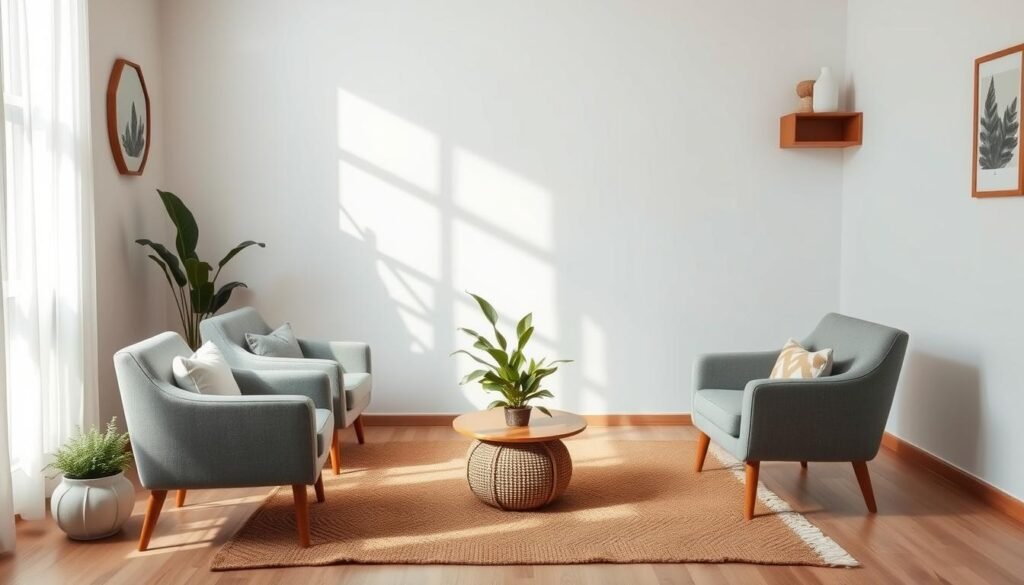In 2022, a staggering 96 percent of psychologists started meeting clients online. The American Psychological Association shared these findings. This big move to online sessions has made it easier for people to find help with anxiety. Now, many wonder if therapy through the internet is as good as meeting face to face. To decide what’s best for them, people need to look at the good and bad of both online and in-person therapy.
Key Takeaways
- Online therapy provides flexibility and accessibility, particularly beneficial for underserved communities.
- Both online and in-person therapy show comparable efficacy and patient satisfaction.
- In-person therapy allows for a richer understanding of non-verbal communication.
- Privacy concerns in online therapy can impact communication about sensitive topics.
- Personal preferences significantly influence an individual’s choice between online and in-person therapy formats.
Understanding Online Therapy
Online therapy lets people get help through technology. It’s great for those who can’t easily visit therapists in person. This method is especially useful for people living in remote areas. Online counseling connects those in need with mental health experts efficiently.
Definition and Delivery Methods
Online therapy offers various ways for clients to connect with therapists. It includes video calls, phone chats, and messaging. Studies show it’s as helpful as traditional therapy for many issues. It’s particularly good for conditions like teletherapy for anxiety.
Popular Platforms for Online Therapy
There are many platforms offering online therapy. Services like BetterHelp and Talkspace stand out. They focus on being easy to use and keeping your information safe. With these platforms, starting therapy feels less overwhelming. To learn more, see how online therapy compares with face-to-face therapy at this link.
What Is Traditional In-Person Therapy?
Traditional therapy, also called face-to-face therapy, happens when clients and therapists meet in person. These sessions usually take place in a professional office or treatment center. Such settings help create a safe and neutral place that’s very important for therapy, especially for those with anxiety or mental health issues.
Overview of Traditional Therapy Settings
In-person therapy settings are made to help with good communication and forming a personal bond. These places often have:
- Comfortable furniture to help clients relax.
- Privacy which allows for honest conversations about sensitive topics.
- Various tools like art supplies or worksheets to aid therapy.
- Features that make sure all clients, no matter their needs, can access therapy.
Typical Session Structure
A normal traditional therapy session lasts about 40 to 60 minutes. In this time, therapists use many methods:
- Initial Assessment: They start by getting to know the client and their main concerns.
- Goal Setting: Together, they set goals to work on specific problems.
- Intervention: They use different approaches tailored to the client’s needs.
- Feedback and Closure: At the end, they look at progress and plan next steps.
These steps form a strong bond between the therapist and client. This is very helpful, especially for those dealing with anxiety disorders.
Pros of Online Therapy
Online therapy is gaining popularity. It offers flexibility, less stigma, and saves money. This makes it a preferred option for people looking for mental health support.
Accessibility and Convenience
Accessibility is a top advantage of online therapy. There’s no need to worry about living far from a therapist. People can get therapy from home at times that work for them. This makes it easy to fit therapy into busy schedules.
Reduced Stigma and Anonymity
Online therapy helps those hesitant to seek help. It offers privacy which can lessen worries about being judged. This encourages people to address their mental health issues.
Cost-Effective Options
Online therapy can be more budget-friendly than traditional therapy. Many therapists offer lower rates for online sessions. This makes getting help more affordable and lets more people put their mental health first.

| Aspect | Online Therapy | In-Person Therapy |
|---|---|---|
| Accessibility | Remote sessions eliminate geographical barriers | Requires travel to a physical location |
| Convenience | Flexible scheduling times available | Often requires strict scheduling |
| Stigma | Anonymity reduces fear of judgment | Potential embarrassment in a public setting |
| Cost | Lower rates and diverse pricing options | Higher fees due to overhead costs |
| Session Attendance | Higher attendance rates reported | Lower attendance due to travel constraints |
Cons of Online Therapy
Online therapy has unique drawbacks that can affect the therapy experience. It’s important for individuals to understand these issues before starting treatment.
Technical Reliance and Connectivity Issues
Technology is crucial in online therapy, but it comes with risks. For example, poor internet or tech problems can mess up sessions. Many people feel upset when these issues interrupt their therapy. This can harm the treatment’s success.
Distractions in Non-Clinical Environments
Getting therapy at home may lead to distractions. Home environments, unlike therapy rooms, have many interruptions. These can come from family, pets, or chores. This makes focusing hard and can lower therapy’s impact.
Privacy and Confidentiality Concerns
Privacy issues are big worries in online therapy. The fear of hacking and data leaks can make clients uneasy. They often worry about who can see their info during sessions. It’s key to have secure communication, but this can be hard to ensure. This can weaken the trust needed for good therapy.

| Drawback | Description |
|---|---|
| Technical Reliance | Dependence on technology may lead to connectivity issues, disrupting sessions. |
| Environmental Distractions | Home settings can lead to interruptions that interfere with therapeutic engagement. |
| Privacy Risks | Concerns about cyber breaches may undermine trust in the confidentiality of sessions. |
Benefits of In-Person Therapy
In-person therapy offers key benefits for those seeking help with mental health. It provides a tailored experience and allows for nonverbal communication. These factors greatly enhance the therapy process.
Nonverbal Communication and Cues
Nonverbal cues are vital in therapy. Therapists can see clients’ facial expressions and body movements. This helps them understand feelings that might not show up in online sessions. In-person meetings help therapists deeply understand a person’s emotions. This is very helpful in therapy with couples or families.
Neutral Therapeutic Space
The therapist’s office is a distraction-free zone that focuses on the client. This space is almost sacred, catering solely to the person’s needs. It’s a safe place for people with serious mental health issues to open up about their thoughts and feelings.
Support for Serious Mental Health Needs
Face-to-face therapy is great for treating complex mental health issues. Studies show that in-person cognitive behavioral therapy (CBT) is more effective for anxiety, depression, and trauma. The personal bond formed in these sessions builds trust and supports better health outcomes.

| Aspect | In-Person Therapy | Online Therapy |
|---|---|---|
| Nonverbal Communication | Highly effective, enables nuanced understanding | Limited to visual cues during video calls |
| Therapeutic Space | Neutral, distraction-free conducive to deep work | Home environment can be distracting |
| Support for Serious Needs | Tailored for complex conditions, fosters strong rapport | May lack depth for serious mental health needs |
| Assessment Thoroughness | Detailed assessments possible | Limited ability to gauge subtle cues |
Drawbacks of In-Person Therapy
In-person therapy is really helpful but has some limits. It’s not always easy for everyone to get the help they need. This is especially true for people living far from cities.
Limited Access to Therapists in Remote Areas
People in remote areas often struggle to find therapists. Qualified mental health professionals are not evenly spread out. This makes it hard for individuals to get the care they need. Online therapy options could offer a solution by making it easier for people to access help.
Time and Travel Constraints
Getting to therapy sessions can also be a big hassle. It takes time to travel, which can be tough on top of life’s stresses. If you don’t have a easy way to get there, it becomes even harder. This is why being able to go regularly is so important for therapy to work.
Want to learn more about therapy choices? Check out this link: Online Therapy vs In-Person Therapy.
Online Therapy vs In-Person for Anxiety
As we look into mental health care, choosing between online and in-person therapy for anxiety is key. Recent research helps us see how each type measures up in effectiveness and how satisfied patients are.
Comparative Effectiveness Based on Studies
Studies show that online cognitive-behavioral therapy (CBT) works well for anxiety and depression, just like in-person therapy does. Analysis of over 27,500 patients found that online therapy is also cost-effective. People getting online CBT with a therapist saw faster life improvements and used fewer medical services.
These results are supported by research from beyond the U.K., confirming that online treatments can be just as beneficial.
Patient Satisfaction and Attendance Rates
People really like online therapy for its flexible scheduling, including nights and weekends. This flexibility leads to better online session attendance compared to in-person therapy. In places where it’s hard to find mental health pros, online therapy helps connect people to care they need.
To make online therapy even more accessible, new policies are being looked into. This aims to boost how satisfied and successful patients are. To dive deeper, check out this study.
| Comparison Factors | Online Therapy | In-Person Therapy |
|---|---|---|
| Effectiveness | Comparable to in-person therapy for anxiety and depression | Traditional, established approach |
| Cost-Effectiveness | More affordable due to reduced overhead costs | Can vary widely based on location and therapist |
| Attendance Rates | Higher due to flexible scheduling | Generally lower, often impacted by travel needs |
| Patient Satisfaction | High ratings, especially for convenience | Personal connection often valued |
How to Choose the Right Therapy Format
Choosing the right therapy format can be hard. It’s important to think about what you need and what you like. You might prefer online therapy if you’re good with tech and want privacy. This decision helps you find the best type of therapy for you.
Assessing Personal Preferences and Comfort Levels
Comfort with your therapy choice is key. Think about how you feel with technology. Decide if you’d rather see a therapist in person or talk to them online. Here are things to think about:
- Comfort with technology for online therapy platforms.
- Preference for a physical environment typical of in-person therapy.
- Expectations regarding therapist interactions and dynamics.
- Freedom to choose communication modes like video calls, chats, or messages.
Considering Therapy Needs and Situational Factors
It’s important to know what kind of therapy you need. In-person therapy might be better for serious mental health issues. But online therapy works well for things like anxiety and depression. Think about:
- The severity of mental health conditions being addressed.
- Access to therapists, especially in remote areas.
- Scheduling flexibility around your life.
- Insurance coverage for therapy, which can ease money worries.
Consider both what you like and what you need for therapy. This will help you make the best choice for your mental health journey.
| Factor | Online Therapy | In-Person Therapy |
|---|---|---|
| Cost | Often lower costs | Typically higher costs |
| Accessibility | Available from anywhere | Dependent on local therapist availability |
| Comfort Level | Varied communication modes | Physical presence of therapist |
| Effectiveness | Effective for common issues | Suitable for severe conditions |
| Flexibility | High flexibility in scheduling | Potential scheduling constraints |
Conclusion
This article looked into what influences the choice between online therapy and face-to-face therapy for anxiety. Each kind has its pros and cons. It’s important for people to consider what works best for them when choosing.
Online therapy is easy to get to and often costs less. But, in-person therapy lets you communicate without words and helps make strong connections. These factors play a big role in the decision process.
About 40.9% of people surveyed faced a mental health issue lately, showing a big need for effective therapy. Interestingly, 44.5% prefer meeting their therapist in person. This shows that despite online options, the personal touch of face-to-face sessions is still highly valued.
To sum up, knowing the differences between online and in-person therapy helps people make better choices for their health. Whether it’s through a screen or in an office, finding the right type of help is key. This allows individuals to get the best support for their unique mental health needs.